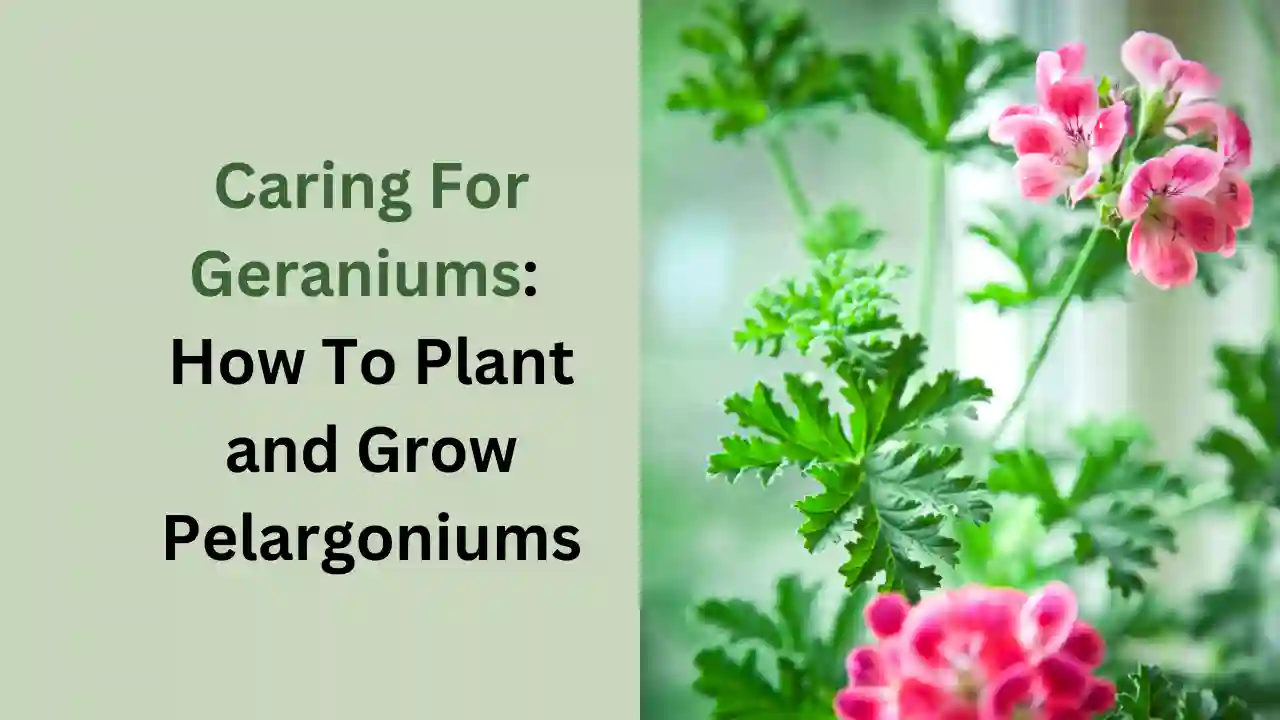Geraniums, an aromatic and colorful flower plant, are commonly planted and are one of the most favorite flowers for any gardener. They are very easy to grow in garden beds and even in hanging baskets and containers. The best time to plant Geraniums is in autumn; they develop their roots in the fall.
So, if you are looking for an answer on how to plant your Geraniums:
Short Answer:
- Take a fine healthy cutting of the Geranium stem.
- Make drainage holes.
- Place it where you want to grow, like garden beds, containers, or pots. It would be economical as compared to replacing them.
You can care for your plant by following good watering techniques, maintaining a good soil drainage facility, and saving your plant from frost and cold. Keep the plant in sunlight for 4-6 hours per day for proper blooming and good growth.
(Please be informed that here I am not discussing Hardy Geraniums, i.e., cranesbill, and only discussing annual geraniums, i.e., pelargoniums. These geraniums are sensitive to cold and need to be brought indoors during winter).
Geranium or Pelargonium?
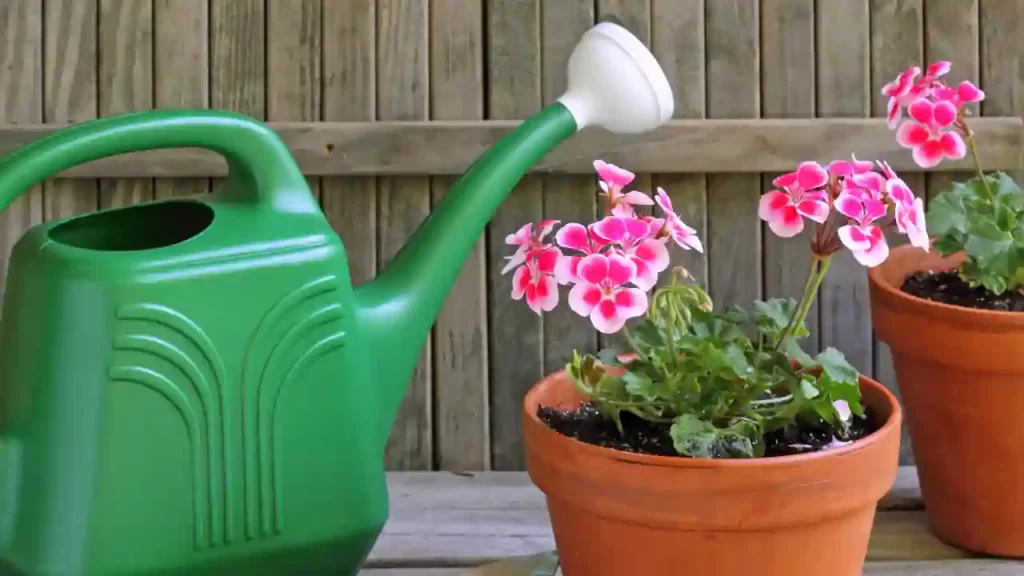
The plant that we call “Geranium” was brought to Europe by Dutch traders. In the early 18th century, Dutch brought the plant from South Africa.
Since the same-looking plant, “Wild Hardy Geraniums,” were already grown in Europe, botanists mistakenly categorized them into the same genus.
Later, in 1753, a botanist named Carl Linnaeus categorized the plant under Geranium. It was after that they noticed that new Geraniums were different from European Geraniums; their petal shape, stamens number, and many other factors were different, so they classified them as Pelargoniums. It means Stork’s bill refers to large, thin, and sharp-pointed seed pods.
The original name of the plant is Stuck, and yet Pelargoniums are commonly said to be geraniums only.
| Botanical Name | Pelargonium spp |
| Plant Type | Houseplant |
| Sun Exposure | Full Sun |
| Bloom Time | Spring, Summer |
| Flower Color | Pink, Purple, Red, White, Multicolor |
| Hardiness Zone | 10, 11 |
Popular Types of Geraniums
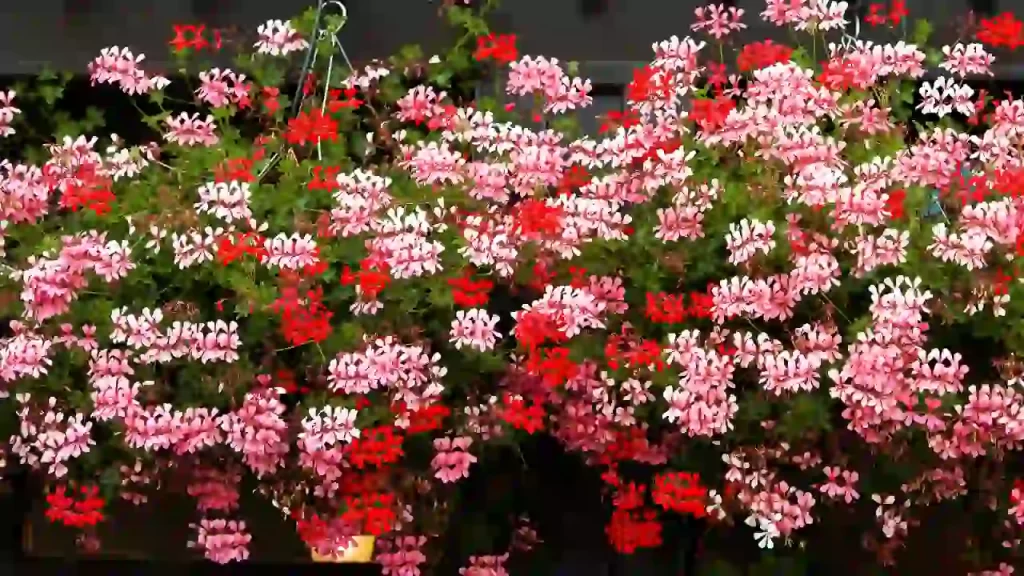
Geraniums are the ultimate adaptable plants, offering over 300 species in their family. Whether it be color, type of bloom and foliage, or scent – geraniums have something for everyone.
They come in a wide range of sizes, from petite six-inch versions to mightier options that can reach several feet tall with an array of blooms!
Let’s explore four of the most sought-after varieties:
- Ivy Geraniums – Ivy geraniums are often grown as houseplants or in hanging baskets due to their trailing habit and delicate five-petal pink, white, red, or violet flowers. The foliage of ivy geraniums is a vibrant green shade with a glossy texture that makes them stand out among other plants on the market.
- Scented-Leaf Geraniums – The foliage of these scented geraniums is a scented delight! They emit an aroma from the oil-producing glands on their leaves when touched or brushed against, making them a delightful addition to any outdoor space. These plants are available in vibrant colors such as white, pink, and purple.
- Zonal Geraniums – They are a garden favorite due to their various colors, shapes, and sizes. Their name comes from the distinct dark circular ‘zone’ in their center, which is common among all varieties of this species. They usually grow to about 18 inches tall with a mounding habit.
- Martha Washington Geraniums (Also known as Regal Geraniums) – Most geraniums of these kind are known for their show-stopping features, offering large 4-inch blooms in vibrant shades of purple, pink, and white. They also have a compact bush-like growth habit that makes them great for container gardening or flower beds. Their foliage is attractive too, with a dark and glossy texture that ensures they stand out in any garden.
Regardless of the type you choose, geraniums make an excellent addition to any landscape or indoor space.
Their hardiness, versatility, and vibrant blooms make them an ideal plant for novice and experienced gardeners alike.
With over 300 species available, there’s sure to be a geranium for everyone!
Planting Geraniums?
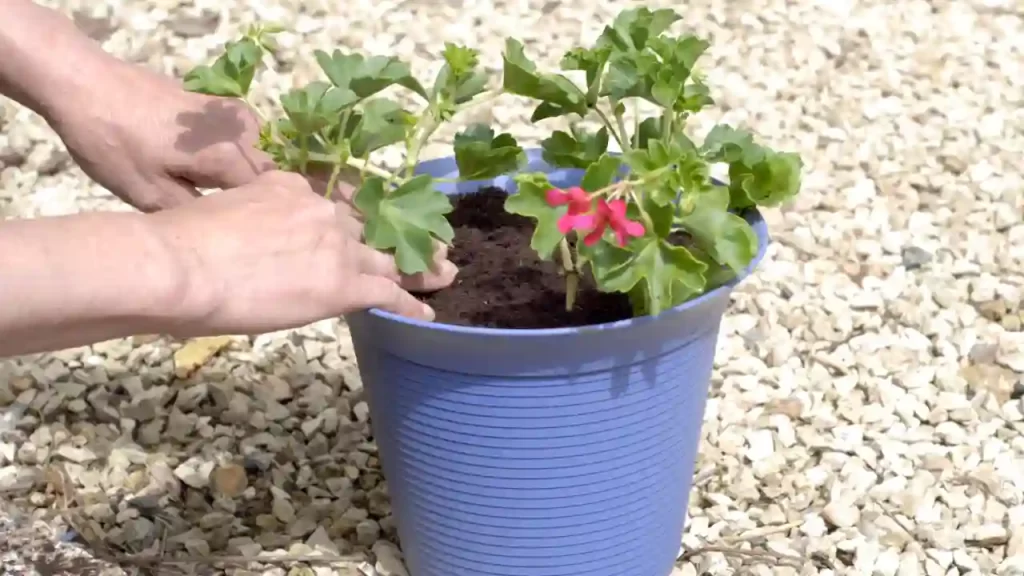
- You can grow Geraniums in pots or containers or as annual flowers. It is quite beneficial to keep them outside in warm weather in sunlight. If you have planted geraniums as houseplants, do not forget to bring the plants indoors in cold weather conditions or during later summer or early fall when the temperature at night goes below 13 degrees celsius or 55 degrees Fahrenheit.
- Closely monitor the size and color of the geranium plants while purchasing. Evenly green-colored leaves with strong stems indicate a sign of a healthy plant. Do not choose a plant with a straggly or uneven shape stem. Ensure not to bring any plant which shows signs of pests also. Generally, mealybugs, whiteflies, and spider mites are very common pests in indoor plants.
- Ensure a good drainage facility by making a hole in the pots. It would reduce the risk of root rot.
- Geraniums prefer to grow in well-drained soil and not in excessively wet, soggy, or compacted soil. Thus, use a properly drained soil mix for planting geraniums in containers. Avoid using heavy or clayey soil.
- I would recommend to keep the plants in at least 4-6 hours of sunlight for a maximum blooming of geranium flowers. (check this post “Geraniums Not Blooming: Reasons And Solutions“if you are having problems with geraniums bloom)
Growing Geraniums?
How To Care For Geraniums?
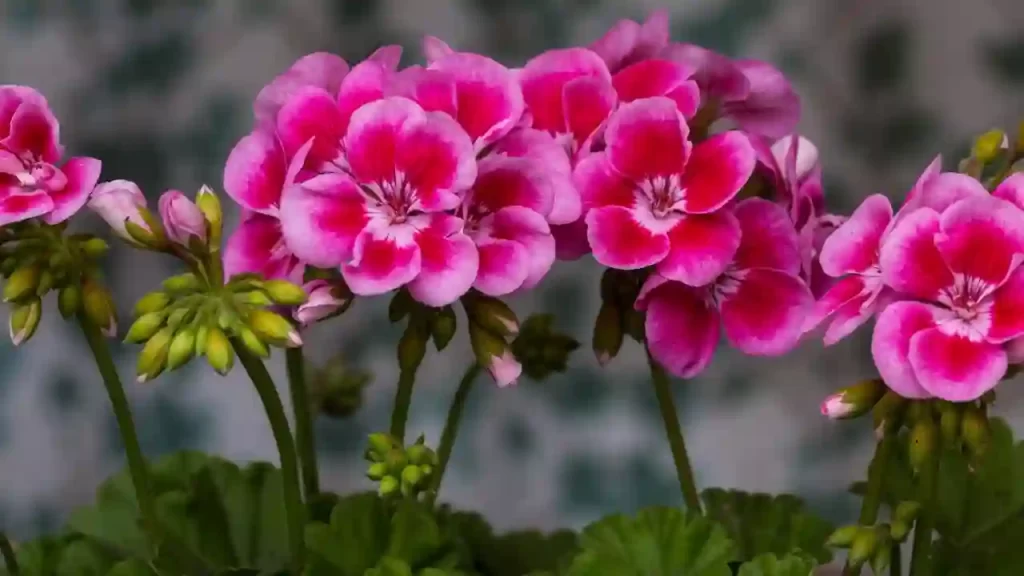
- Check the moisture level of the soil before watering. If the soil’s top inch is dry, you can water the plant.
- Avoid frequent watering during winter months but do not let the roots completely dry out. Geraniums perform great when allowed some dormancy during winter months. During winters, they require less water and grow slowly and steadily. I have discussed this below in detail.
- Remove faded or dead flowers from the plant to encourage blooming.
- To discourage leggy stems and encourage bushiness, prune back the stem.
- Use good fertilizer once every two weeks during the growing season. Using a water-soluble fertilizer is best recommended. Avoid fertilizers during winter when your plant is dormant.
- You can re-pot the geranium plants in spring to have new growth or when they need to be refreshed.
Overwintering Geraniums
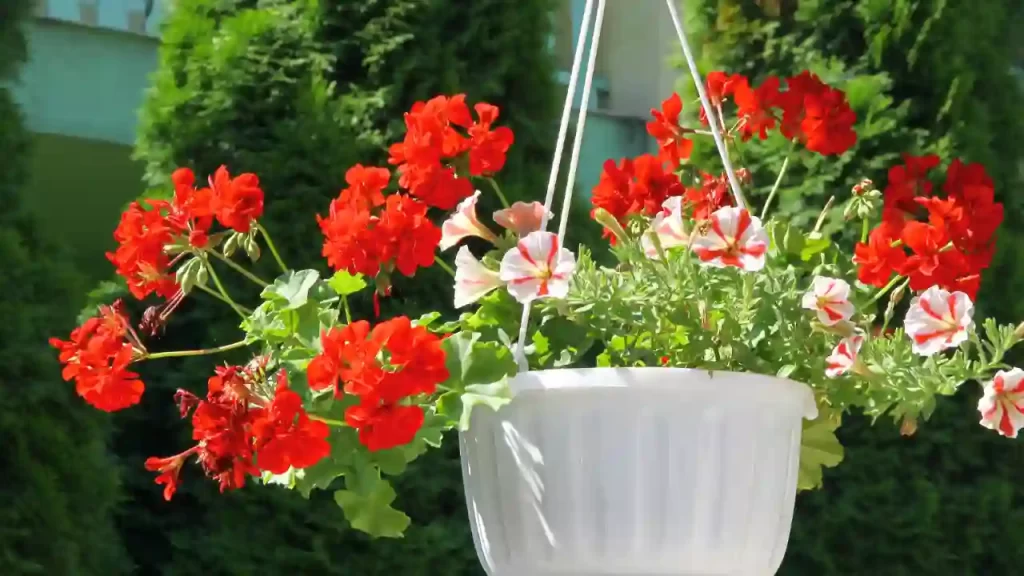
- If you have kept geraniums indoors during summer, you can still keep them indoors if they get adequate sunlight. There may be a lack of adequate sunlight in northern climates during late winter to set buds on some of the geranium plant varieties.
- Before the start of the first fall frost, using a clean, sharp knife, cut the plant’s stem sharply up to 6-8 inches. Here they don’t need to utilize their energy to grow leaves in low sunlight areas where they are about to be placed.
- “Mother Plant” should be transplanted in the smallest pot, which can just fit its roots. You can use normal potting soil for this.
- Place your geranium plant in the shade for one week. Later find a sunny spot and keep your plant there. Ensure they get the adequate amount of required sunlight and keep the plant cool.
- The best-fitted night temperature in winter for the plant’s growth is 50 to 60 degrees Fahrenheit, i.e., 10 to 16 degrees Celsius. They will only survive if they are kept relatively dry at 32 to 80 degrees Fahrenheit, i.e., 0 to 27 degrees Celsius.
- Prune the old leaves when new leaves grow.
It is tough to maintain a plant’s growth rather than getting a new one. I have listed some tips to maintain the continuous growth of your geraniums:
- It is better to water your plant only when its leaves show signs of falling. In this situation also, provide only a small amount of water. Do not feed your plant in any way, and stop giving fertilizers. Your Geranium should get proper rest to grow uninterruptedly.
- If you wish to see your overwintered geraniums blooming during summer, prune them in February. As and when the frost ends and the risk of cold is gone, bring your plant outdoors in sunlight, and you can transplant them in pots, containers, or garden beds.
Harvesting Geraniums
Geraniums can form roots simply from stem cuttings in soil, water, perlite, or other material needed for root material.
- Use a clean, sharp knife and make an angle to mark a tilted cut on the stem of the Geranium, just above the nodes from where the leaves come out. Remove the buds, if any, and leave only two to three leaves on the stem.
- Take the cut and rap in a newspaper. Preserve in the shade for 24 hours at least to dry out the cut ends. It prevents the stem from rotting.
- Now keep that stem in a damp pot and place it in a shady and warm place for two continuous days. Now, put the pruned plant to the indirect sun and moisten the medium when required.
Wit And Wisdom
- Geranium leaves work best if you have a minor cut. You can crush some of its leaves and apply them to the cut area. It reduces bleeding.
- Pelargonium Geraniums mean silliness in the language of flowers.
- Japanese beetles hate geraniums. So, you can easily prevent these annoying pests with geraniums.
- You must keep Pests and children away from geraniums as they can cause vomiting and indigestion in young children and pets.
Geraniums Pests and Diseases
Geraniums can become prone to various pests and diseases due to the following reasons:
- Not keeping the plant for at least 4-6 hours in sunlight per day.
- Over or under-watering of the plant.
- Improper soil drainage facilities.
In such conditions, your geranium plant’s leaves would turn yellow, and even your plant would wilt.
So keep them in proper sunlight and water them adequately. Also, maintain a good soil drainage facility.
Geraniums Varieties We Recommend
- If you are planning to grow your geraniums in a container, go for Common or Zonal Geraniums (Pelargonium x hortorum). It thrives well in containers and outdoors too.
- Ivy-Leaf Geraniums (Pelargonium peltatum) is beneficial to grow in hanging baskets, window boxes, and containers.
Summary
Annual Geraniums are lovely and aromatic flowers loved by most gardeners. Geranium cuttings are placed in containers, pots, or beds to grow into a plant. It is challenging to plant them in such a manner, but if you follow the above-discussed tips and tricks, it will be fun and exciting to plant them.
Ensure to water them properly, expose them to the sunlight, protect them from frost and cold, and maintain a good soil drainage facility. It would help your plant to be away from any pests and diseases. And you can enjoy lovely colorful, scented geranium flowers almost every season.
Frequently Asked Questions
Do geraniums come back every year?
Yes, Geraniums can come back year after year. A geranium’s exact lifespan will depend on your variety and how it is cared for. Most varieties will live for several years if given proper care. It is possible to grow geraniums from seed, but it is often easier to purchase already established plants.
When planted in well-drained soil, kept moist, and provided with adequate sunlight, geraniums can thrive and flower all summer long.
For a lovely springtime bloom, potted geraniums just need to be brought indoors during winter. In order for them to thrive, expose the plants to 55 degrees F while shielding them from chilly nights and frosts.
Are geraniums annuals or perennials?
Geraniums are classified as both annuals and perennials. Annual geraniums (Pelargonium x hortorm) bloom from spring until frost, while perennial geraniums (or true geraniums, or cranesbills, as they’re sometimes called – botanical name: Geranium spp.) are evergreen, with blooms appearing intermittently throughout the year.
As a general rule of thumb, annual geraniums are planted directly in the ground and will die back at the end of each growing season.
Perennial geraniums can be grown in containers or planted directly into the soil, and they’re hardy enough to survive the winter in most climates.
Can you grow geraniums from seed?
Yes, you can grow geraniums from seeds! This is a relatively easy process that requires only minimal supplies. You’ll need geranium seeds, potting soil or seed starting mix, and small pots or trays.
